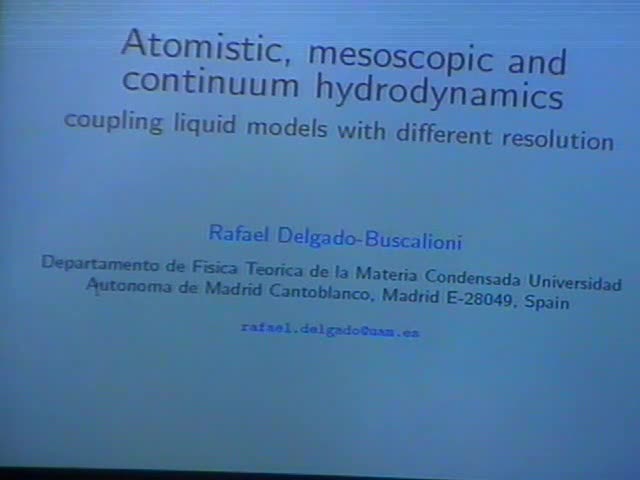Atomistic, mesoscopic and continuum hydrodynamics: coupling liquid models with different resolution
Presenter
November 7, 2008
Keywords:
- Multiple scale methods
MSC:
- 34E13
Abstract
The final goal of multiscale methods based on domain decomposition, is
to retain full atomistic
detail only where needed (within a region of interest), while using
a coarse-grained model to introduce the essential information about the
surroundings dynamics. Importantly, the atomistic region becomes an open
sub-system
which exchanges mass, momentum and energy with the exterior. The
hydrodynamics of flux exchange can be
solved using an hybrid molecular-continuum description (hybrid MD)
[1,2]. However, molecule exchange across the hybrid interface becomes
a complicated task as one deals with more complicated molecules,
essentially owing to larger steric hindrance. A way to solve this
bottleneck is to combine hybrid MD with adaptive coarse-graining. The
set-up is like the layers of an onion [3]: the atomistic model lies at
the core, surrounded by a thermodynamically compatible coarse-grained
model, which interfaces with a continuum description of the liquid
(maybe also including hydrodynamic fluctuations). Finally, open
boundary conditions for the continuum description [4] allow evacuation
of (shear, heat or sound) waves out of the whole system, and let it
behave in a grand-canonical way, in contact with the prescribed
outer thermodynamic state.
[1] G. De Fabritiis, R. Delgado-Buscalioni and P. Coveney, Phys. Rev.
Lett.97, 134501 (2006)
[2] R .Delgado-Buscalioni and G. De Fabritiis, Phys. Rev. E 76, 036709
(2007)
[3] R. Delgado-Buscalioni, K. Kremer and M. Praprotnik, J. Chem. Phys.
128, 114110 (2008)
[4] R. Delgado-Buscalioni, A. Dejoan, Phys. Rev. E, in press, (2008)
